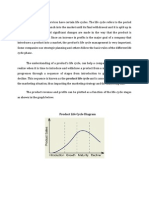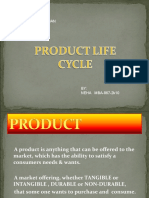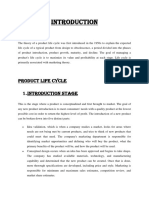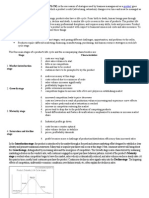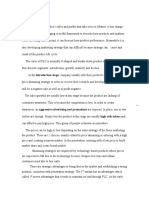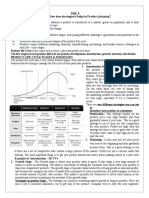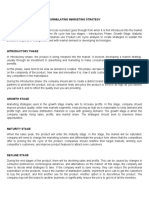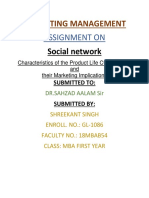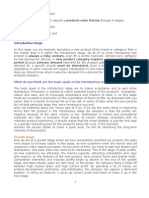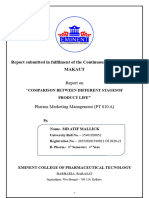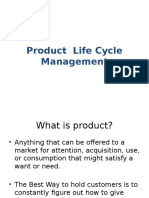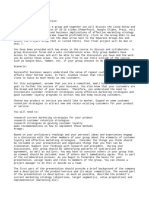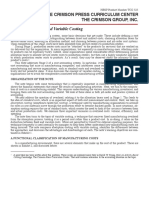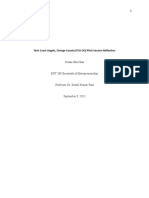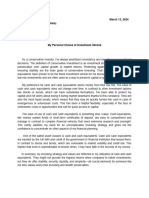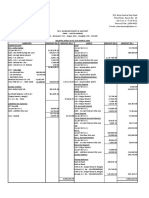Discussion Assignment Unit IV
In the discussion forum, you are expected to participate often and engage in deep
levels of discourse. Please post your initial response as early as possible and
continue to participate throughout the unit. You are required to post an initial
response to the question/issue presented in the Forum and then respond to at least
3 of your classmates’ initial posts. You should also respond to anyone who has
responded to you.
The product life cycle helps to inform decisions made by marketing managers.
Examine two products that you are familiar with, one that is in the early stages of
the product life cycle and one in the mature stage.
How is the marketing different for the two products?
What improvements to the marketing strategy would you recommend for each if you
were the marketing manager?
Your Discussion should be a minimum of 250 words in length and not more than 750
words. Please include a word count. Use APA citations and references for the
textbook and any other sources used.
***********************************************************************************
*************************************************************
The Product life cycle is a conceptual and planning tool which provides a means of
describing the sales patterns of goods or service products, over their time in the
market. There are four stages of product life cycle namely Introduction stage,
growth stage, maturity stage and decline stage. This work analyses the Introduction
stage and growth stage in details for FMCG products in Indian market. The growth
and decline stages will also be defined briefly. FMCG goods are fast moving
consumer goods that has very short marketing windows to place the product in the
market (Sharma, N. (2013). These goods fulfils our day to day needs like food,
beverages, beauty products, toiletries, frozen foods, baked items, cleaning
products, consumer electronics and clothing etc. At early stage of introducing any
of these new products in the market there are several issues which needs to be
considered before or on launch. These issues include,
1. Product popularity: At the introduction phase the product is not popular to
consumers. Consumers are sceptic of purchasing it or trying it for first time.
2. Extensive Market study before launch: At this stage a company can pursue one of
four strategies – Rapid Skimming, slow skimming Rapid penetration and slow
penetration. These strategies are applied after extensive market research and
competitor analysis.
3. Time and Patience: It takes time of a new product to begin selling in volume.
There can be manufacturing or logistics issues. The marketplace is unfamiliar with
the product and creating awareness takes time. Consequently product sales show a
slow growth during the introduction phase.
4. Money: The product may not make a lot of profit at this stage. It is the time to
push a lot of money to test the market, promotion, advertising, setting up
distribution channels and creating awareness of the product in consumer's mind. The
FMCG must be prepared to spend a lot of money and get only a small proportion of
that back.
5. Perception of consumer and market orientation: A very good knowledge of the
market and of what a customer is willing to pay for a new product. The FMCG can
also adjust price, place and promotion to meet their target sales. For example, in
large markets and high potential competition it would make sense to invest heavily
in promotion and start with a lower prices. This strategy may also apply for
products for which production cost would decline quickly with economies of scale.
Using this strategy, the FMCG can penetrates quickly before competitors has a
chance to introduce competing products at their growth stages.
The product pass the growth stage to reach the mature stage. The mature stage is
�characterized by features far different from the introduction and growth phase. The
growth space is characterized by a increase in sales volume leveling off. At this
point competition is strong and margins may begin to suffer following the growth
stage. At maturity stage, the sales continue to increase but at the decreasing rate
until become stable, because of price competition. The product reaches its peak at
this stage, most companies fight aggressively to maintain their market share. The
competition is very intense, unfortunately a small firms will die one by one
(Sharma, N. (2013). Signs of getting to this stage are that competitors may start
advertising more strongly or using other promotional means to increase sales. A
company that has achieved its market share goal enjoys the most profitable period,
while a company that falls behind its market share goal, must reconsider its
marketing positioning into the marketplace. During this period new brands are
introduced even when they compete with the company's existing product while changes
are more frequent (product, brand, and model). This is the time to extend the
product's life. A successful product maturity phase is extended beyond anyone's
timely expectations. A good example of this is “Tide” washing powder, which has
grown old, and it is still growing. The decision for withdrawing a product seems to
be a complex task and there a lot of issues to be resolved before with decide to
move it out of the market. Sometimes it is difficult for a company to conceptualize
the decline signals of a product. Usually a product decline is accompanied with a
decline of market sales. Its recognition is sometimes hard to be realized, since
marketing departments are usually too optimistic due to big product success coming
from the maturity phase. This is the time to start withdrawing variations of the
product from the market that are weak in their market position. The prices must be
kept competitive and promotion should be pulled back at a level that will make the
product presence visible and at the same time retain the “loyal” customer. Finally
in Decline Phase the product sales begin to decrease and it is at this point that
some serious marketing decisions need to be made to withdraw the product from the
market.
Improvements to the marketing strategy at each phase
1. In the early phase a marketing manager should have strong strategy and plans to
introduce the product in the market. The window of marketing should be properly
identified failing which there can be severe of loss of revenue and sales. There
should be a detail market research and customer orientation through surveys to know
how much consumers are ready for this new product and how much are they willing to
pay for it on launch. There should be a right strategy for promotion of the product
to create product awareness. A right balance of price strategy to penetrate the
market on the basis of economy of scale should be implemented at this stage to reap
the benefit of early movers. Also, it is extremely important to recognize when the
product sales are taking off and entering the growth phase in order to adapt to
strategy of growth stage.
2. In the mature stage it is extremely important to recognize the forecasting of
sales at early mature phase to deliver stable sales volume and meet the targets. It
is important to keep an eye on competitor's offerings at this stage due to several
competitors in the market. Product cannibalization can occur at this stage to
decides to replace an existing product and introduce a new one in its place,
regardless of its position in the market. This is due to newly introduced
technologies. The trick in cannibalization is to know when and why to implement it,
since bad, late or early cannibalization can lead to bad results for company sales.
Also it is very important to understand the decline of sales volume at this stage
to take necessary action to withdraw from the market.
Conclusion:
Marketing managers manage a products life cycle and enables a company to take all
the decisions needed during each phase of a product's life cycle. The way a
product's success is measured depends on where the product is in its life cycle. So
the product manager must understand the strategic company direction and translate
�that into product strategy and product life cycle position.
References:
Sharma, N. (2013). Marketing strategy on different stages PLC and its marketing
implications on FMCG products. International Journal of Marketing, Financial
Services & Management Research, 2(3), 121-136.
The University of Minnesota. Chapter 8 (2010). Principles of marketing. Licensed
under Creative Commons Attribution-Noncommercial-Share Alike 4.0.

